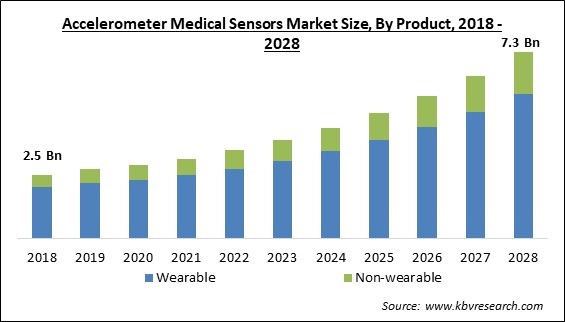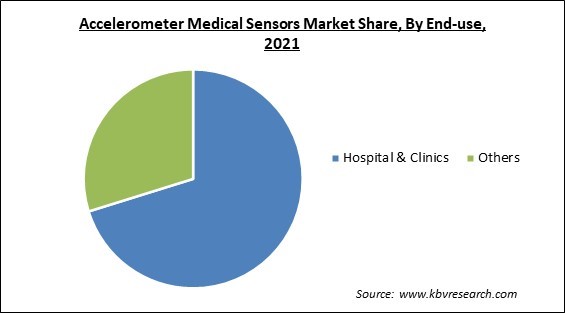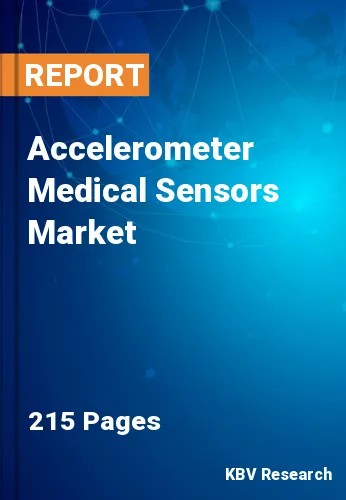The Global Accelerometer Medical Sensors Market size is expected to reach $7.3 billion by 2028, rising at a market growth of 13.3% CAGR during the forecast period.
A type of medical sensor called an accelerometer are sensors that track the velocities of moving objects along established axes. Because acceleration is related to external force and can therefore reflect the frequency and intensity of human movement, utilizing accelerometry to measure physical activity is highly preferred. By aggregating accelerometry information with respect to time, displacement and velocity information can be obtained.

When accelerometer sensors rotate with objects, some of them can react to gravity to give tilt sensing in relation to reference planes. Classifying bodily postures can be done using the inclination data that is produced (orientations). With these features, accelerometry is able to provide accurate data for determining physical activity and a variety of human activities.
In order to detect and evaluate physical activity in either laboratory/clinical settings or free-living scenarios, accelerometers have gained widespread acceptance as practical and useful sensors for wearable and non-wearable technology alike. Accelerometers were superior to previous methods for precisely tracking human movement. In addition, the price of accelerometers in smaller form factors has decreased because of micro-electromechanical system (MEMS) technology. While this is going on, sensor performance has improved, and battery consumption has significantly decreased.
Historically, sensors for monitoring physical activity levels worn and based on accelerometers have been expensive and made expressly for research. Nonetheless, the general public now has access to accelerometry-based assessments of physical activity owing to the relatively recent development of inexpensive, simple-to-use, and consumer-oriented sensors, like Fitbits.
The need for medical sensors increased during the pandemic. The need for sensors was further fueled by the requirement for ongoing monitoring of patients with disorders and the miniaturization of monitoring tools. The manufacturers of accelerometer medical sensors were further driven to innovate by the rising demand. As a result, the pandemic had a favorable effect on the accelerometer medical sensors market.
More than one-third of people on the planet access the internet at greater bandwidths. As a result, more smart devices can now connect to the internet. In the wearable environment, smartphones are one of the most widely used portable devices, and they are largely utilized to gather and track fitness and health data. Moreover, wearable technology is a crucial component of IoT and M2M platforms, causing an increase in linked devices globally. As a result, the market for accelerometer medical sensors is projected to grow along with the increasing use of wearable technology and IoT.
Doctors, nurses, as well as other clinical personnel can keep an eye on patients regardless of whether they're at the healthcare facility or home owing to wearable medical gadgets. With the ability to remotely measure patient physiologic data in real-time, healthcare facilities can free up rooms, and clinicians can monitor patients' vitals from any place, and efficiency increases. Therefore, the many benefits of medical sensors have aided in their increased usage in the healthcare sector, thereby propelling the growth of the accelerometer medical sensors market.

One of the major challenges for wearables is security, as connected medical device cyberattacks are on the rise. By adhering to Food and Drug Administration (FDA) as well as other security regulations, medical equipment can be made foolproof. However, to successfully execute these stringent regulations, businesses that produce wearable medical sensors technology for the healthcare industry must hire internal IoT engineers or a trustworthy outside consultant. Therefore, the increasing risks of data leaks from wearable medical sensors obstruct the expansion of the accelerometer medical sensors market.
Based on product, the accelerometer medical sensors market is categorized into wearable and non-wearable. The wearable segment garnered the highest revenue share in the accelerometer medical sensors market in 2021. Medical sensors with wearable accelerometers make measuring and monitoring a person's movements and physiological activities possible. Medical sensors with wearable accelerometers can be fastened to the body or clothing, shoes, headbands, and wristbands. Many health indicators, including blood pressure, pulse, heart rate, calorie intake, and others, are tracked, monitored, and recorded using wearable sensors.
On the basis of application, the accelerometer medical sensors market is divided into chronic illness & risk-monitoring, wellness monitoring, in hospital clinical monitoring, sensor therapeutics, and post-acute care monitoring. The chronic illness and risk-monitoring segment acquired the largest revenue share in the accelerometer medical sensors market in 2021. The segment's expansion can be attributed to a rise in the prevalence of cardiovascular illnesses like congestive heart failure (CHF) and hyperlipidemia. Also, it is expected that factors like unhealthy lifestyles, a rise in stress, and poor eating and sleeping habits would increase the prevalence of chronic diseases.
Based on end-use, the accelerometer medical sensors market is segmented into hospitals & clinics and others. The others segment recorded substantial revenue share in the accelerometer medical sensors market in 2021. This segment comprises ambulatory surgical centers (ASCs), long-term facilities, and home care. It is an efficient, cost-effective replacement for a surgery room at a hospital. Additionally, facilities like ASCs are expected to be less costly than hospital stays and help cut costs by lowering patient out-of-pocket spending. An ASC is an excellent alternative for patients who must be in hospitals for an extended period of time.
| Report Attribute | Details |
|---|---|
| Market size value in 2021 | USD 3.1 Billion |
| Market size forecast in 2028 | USD 7.3 Billion |
| Base Year | 2021 |
| Historical Period | 2018 to 2020 |
| Forecast Period | 2022 to 2028 |
| Revenue Growth Rate | CAGR of 13.3% from 2022 to 2028 |
| Number of Pages | 215 |
| Number of Table | 349 |
| Report coverage | Market Trends, Revenue Estimation and Forecast, Segmentation Analysis, Regional and Country Breakdown, Companies Strategic Developments, Company Profiling |
| Segments covered | Product, Application, End-use, Region |
| Country scope | US, Canada, Mexico, Germany, UK, France, Russia, Spain, Italy, China, Japan, India, South Korea, Singapore, Malaysia, Brazil, Argentina, UAE, Saudi Arabia, South Africa, Nigeria |
| Growth Drivers |
|
| Restraints |
|
On the basis of region, the accelerometer medical sensors market is analyzed across North America, Europe, Asia Pacific, and LAMEA. The North America segment procured the highest revenue share in the accelerometer medical sensors market in 2021. This is due to factors including the region's established healthcare infrastructure, substantial healthcare spending, the existence of monopolistic market players, and the quick uptake of cutting-edge technologies. The rising incidence of accidents, sports injuries, and lifestyle-related health disorders are additional reasons that are projected to fuel market growth.
Free Valuable Insights: Global Accelerometer Medical Sensors Market size to reach USD 7.3 Billion by 2028
The market research report covers the analysis of key stake holders of the market. Key companies profiled in the report include Fitbit, Inc (Google LLC), Analog Devices, Inc., Koninklijke Philips N.V., ResMed, Inc., Compumedics Limited, Garmin Ltd., Aetna, Inc. (CVS Pharmacy, Inc.), BMC Medical Co., Ltd., and SOMNOmedics GmbH.
By Product
By End-use
By Application
By Geography
The global Accelerometer Medical Sensors Market size is expected to reach $7.3 billion by 2028.
Increasing miniaturization and connectivity trends in medical sensors are driving the market in coming years, however, Medical gadgets connected to the internet are vulnerable to data leaks restraints the growth of the market.
Fitbit, Inc (Google LLC), Analog Devices, Inc., Koninklijke Philips N.V., ResMed, Inc., Compumedics Limited, Garmin Ltd., Aetna, Inc. (CVS Pharmacy, Inc.), BMC Medical Co., Ltd., and SOMNOmedics GmbH.
The Hospital & Clinics segment is leading the Global Accelerometer Medical Sensors Market by End-use in 2021 thereby, achieving a market value of $4.9 billion by 2028.
The North America market dominated the Global Accelerometer Medical Sensors Market by Region in 2021, and would continue to be a dominant market till 2028; thereby, achieving a market value of $2.4 billion by 2028.
Our team of dedicated experts can provide you with attractive expansion opportunities for your business.

